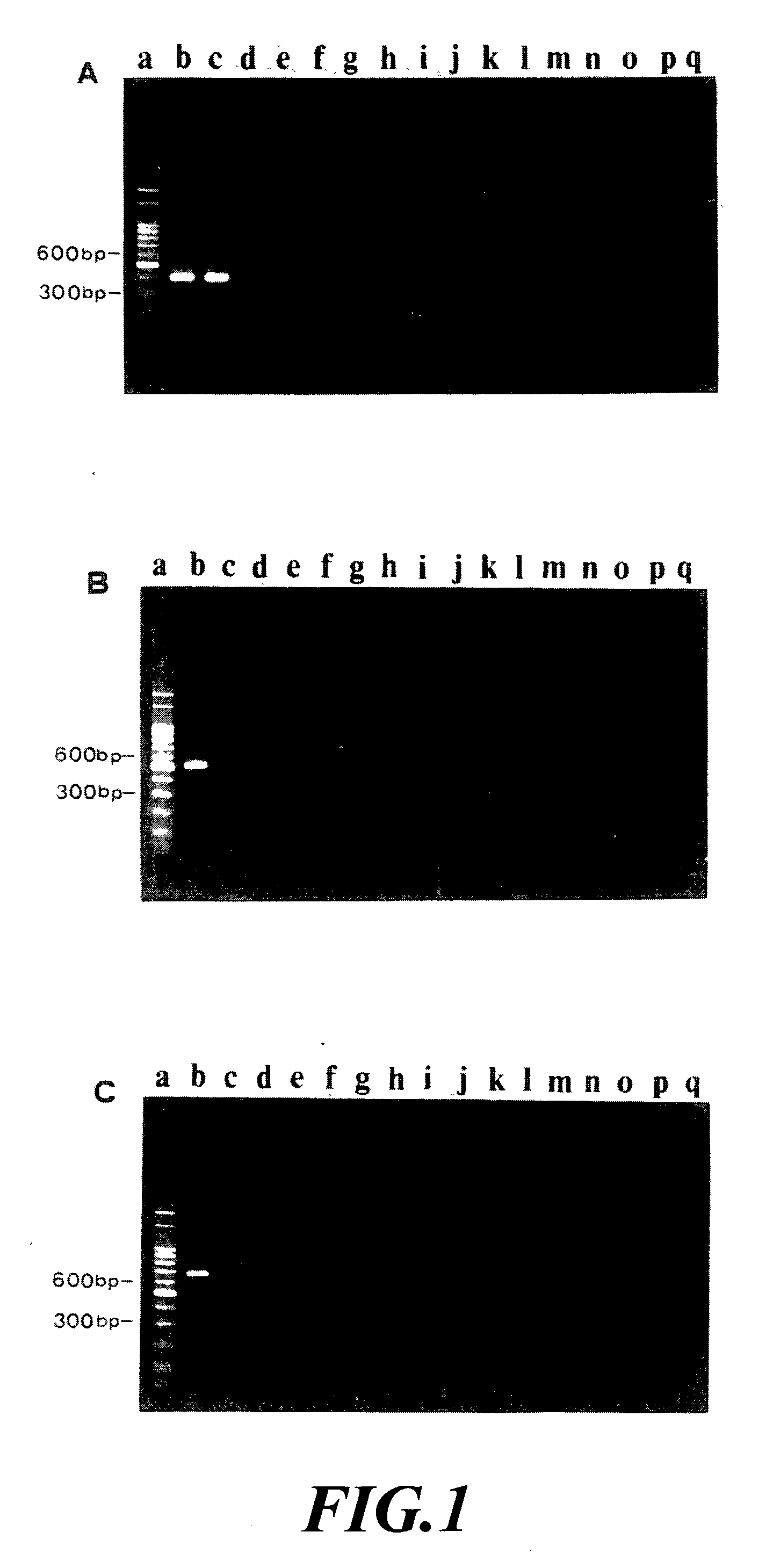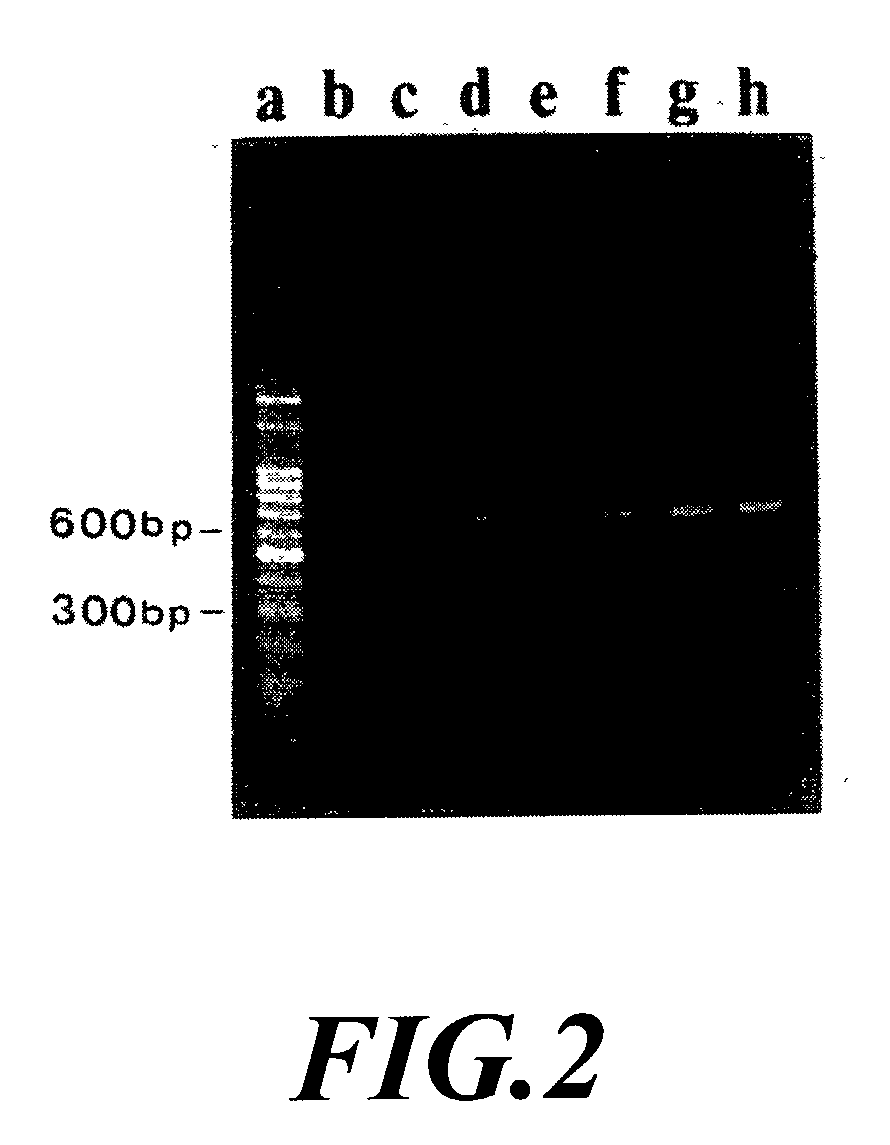Primers useful in polymerase chain reaction for the identification of subtypes c1, c2 and c3 of staphylococcal enterotoxin type c
a technology of staphylococcal enterotoxin and primer, which is applied in the field of primers useful in polymerase chain reaction for the identification of subtypes c1, c2 and c3 of staphylococcal enterotoxin type c, can solve the problems of difficult identification of subtypes and no method available for further identification of subtypes
- Summary
- Abstract
- Description
- Claims
- Application Information
AI Technical Summary
Benefits of technology
Problems solved by technology
Method used
Image
Examples
example 1
[0037] Results of the detection and sensitivity test performed on S. aureus stains producing standard staphylococcal enterotoxin C1, C2 and C3 and non-C type strains were listed in Table 1 and 2 as well as shown in FIGS. 1 and 2, wherein the PCR conditions were the same as described above. It is found that primers designed according to the invention produced specific PCR products only in their targeted enterotoxin-producing strains. These specific PCR products exhibited a size in consistent with the product size as predicted by the original design, i.e., 402 bp, 501 bp, and 672 bp, respectively. Among them, PCR using the primer set of ENTC1 / ENTCR could detect standard enterotoxin-producing strain of type C, CCRC 12654 and FRI 137. The standard enterotoxin-producing strain of type C, CCRC 12654, was derived from strain ATCC 19095 that was isolated in the Food Research Institute of the Wisconsin University, USA, and assigned as FRI 137. Other non-staphylococcal bacterial strains could...
example 2
[0038] PCR detections with primer sets ENTC1 / ENTCR-ENTC2 / ENTCR-ENTC3 / ENTCR designed according to the invention were carried out on 39 enterotoxin-producing S. aureus strains type C that had been isolated in 20 cases of food poisoning by the Third Branch of the Disease Control Agency, the Health Administration, Executive Yuan, ROC during 1995-2000. PCR and analytical conditions were same as described above. The result is shown in Table 3.
[0039] It can be seen from Table 3 that identification of subtype C1, C2 and C3 performed on the above-mentioned 39 enterotoxin-producing S. aureus type C by PCR using primer sets according to the invention revealed one staphylococcal enterotoxin subtype C1, 12 strains of subtype C2, and 13 strains of subtype C3, as well as 13 strains of other type C. Therefore, among those pathogenic S. aureus, staphylococcal enterotoxin subtypes C2 and C3 are the prominent ones with a proportion of about 64%, and only 1 subtype C1 strain, while with about 33% of o...
example 3
[0040] PCR detections with primer sets ENTC1 / ENTCR-ENTC2 / ENTCR-ENTC3 / ENTCR designed according to the invention were carried out on 10 enterotoxin-producing S. aureus strains type C (FRI strains No 202, 248, 293b, 406, 412, 414, 418, 423, 429, 623) that had been provided by the Food Research Institute (FRI) of the University of Wisconsin, Madison, Wis., USA. PCR and analytical conditions were same as described above. The result is shown in Table 3.
[0041] It can be seen from Table 3 that identification of subtype C1, C2 and C3 performed on the above-mentioned 39 enterotoxin-producing S. aureus type C by PCR using primer sets according to the invention revealed 8 staphylococcal enterotoxin strains of subtype C2, 1 strains of subtype C3, and 1 strains of other type C, while no subtype C1. Therefore, this result is similar to that of Example 2, i.e., among those pathogenic S. aureus type C, staphylococcal enterotoxin subtypes C2 and C3 are the prominent ones.
[0042] Many changes and mod...
PUM
| Property | Measurement | Unit |
|---|---|---|
| Fraction | aaaaa | aaaaa |
Abstract
Description
Claims
Application Information
 Login to View More
Login to View More - R&D
- Intellectual Property
- Life Sciences
- Materials
- Tech Scout
- Unparalleled Data Quality
- Higher Quality Content
- 60% Fewer Hallucinations
Browse by: Latest US Patents, China's latest patents, Technical Efficacy Thesaurus, Application Domain, Technology Topic, Popular Technical Reports.
© 2025 PatSnap. All rights reserved.Legal|Privacy policy|Modern Slavery Act Transparency Statement|Sitemap|About US| Contact US: help@patsnap.com



